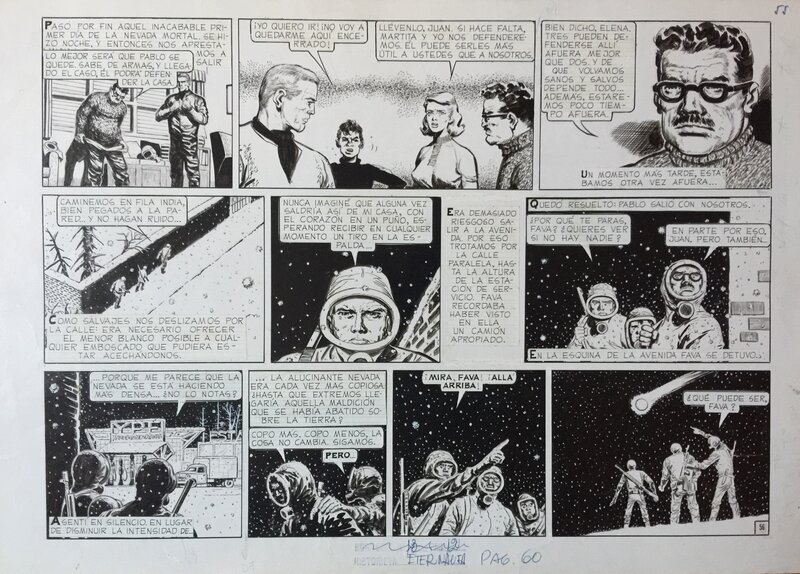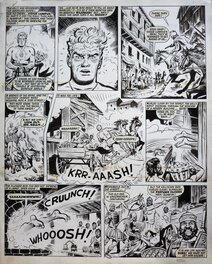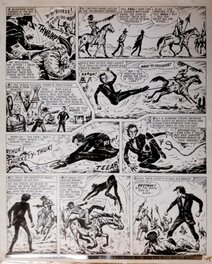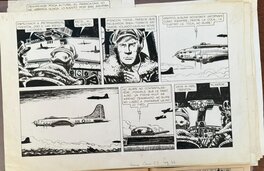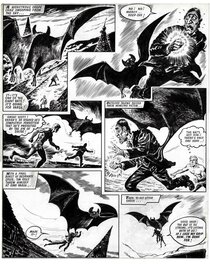Dans la collection de ChrisK
Description
Page 55
Commentaire
Can you think of a comic that touches our national conscience so deeply that our citizenship plasters the protagonist from it all over our public spaces in the form of murals, graffiti and pop art? That’s what The Eternaut is in Buenos Aires. And, its impact is not just evidenced there – it was released in Spain & Mexico and subsequent translations have been published in Croatia, France, Greece, Italy and now the United States, all to great acclaim.
El Eternauta is an Argentinean science fiction comic strip created by Hector German Oesterheld (writer) and Francisco Solano Lopez (artist). It was first published serially in Hora Cero Suplemento Semanal from 1957 to 1959 (first date of publication was September 4, 1957). It was collected and reissued in 1961 in a dedicated magazine, Eternauta.
The basic story (without giving too much away) is a group of individuals organizing to resist an alien invasion. Individuals organizing into a ‘group hero’ was a core belief of Oesterheld’s (he and Ayn Rand would have made interesting coffee mates). He believed in the ‘collective hero, humanity’ – and, while I disagree with his contention that ‘the only real hero is en masse, never the individual hero’, his belief in people working together for a common good permeates the story. As Martin Hadis wrote in his forward to the Fantagraphics edition in 2015, “Oesterheld centers his narrative on the adventures, trials and struggles of a small group of friends, who attempt to survive while they try to come to grips with the magnitude of the devastation they are facing.” The result is “an observation of our primal instincts and fear, an homage to heroism, friendship, and camaraderie, and an insightful anticipation of what the future would bring about: to Argentina, to the world, and to the author himself.” What Oesterheld may have originally written as an allegory for class struggle would eventually become a more direct attack on government repression. As he himself would state, “My stories are filled with allegory and have a message to convey.”
Along those lines, the initial publication and the subsequent first reissuance both preceded the Guerra Sucia in Argentina, the ‘Dirty War’ – a time of state terrorism in Argentina from roughly 1974 to 1983 (although some mark the start as early as 1969) during which the Argentine Military Government hunted down and killed left-wing guerrillas, political dissidents and anyone believed to be associated with socialism. The tally of victims – known as ‘the disappeared’ - range from 15,000 to 30,000. The worst repressions and killings are said to have taken place post-1977, when the guerrillas had already been defeated and anyone considered an ideological threat was targeted – including church and labor union leaders, artists, intellectuals and university students and professors.
After returning to the Eternaut in 1969 and 1975 with a remake and a sequel, respectively – both with a much more political script (it was effectively an open critique of dictatorial regimes) given Oesterheld’s deep concern with the country’s political repression - Oesterheld was ‘disappeared’ in 1977. He was subsequently seen in prison and is believed to have died sometime in 1979 at the hands of government forces. His daughters, who had joined him in a banned leftist organization, were also ‘disappeared’ along with their husbands. Francisco Solano Lopez fled Argentina to Spain for fear of befalling the same fate.
In addition to its political themes and ties, The Eternaut includes many cultural references to daily life in Buenos Aires – its games (the trick-taking card game of Truco), its central community gathering points (the gazebo at the Barrancas de Belgrano and the Plaza de los Dos Congresos that become a command center and headquarters for different groups/characters, respectively) and even its street names and graffiti are drawn directly from the time in which the story is written. The result in an incredibly rich and ‘real’ visual and cultural backdrop against which the story is crafted.
El Eternauta is an Argentinean science fiction comic strip created by Hector German Oesterheld (writer) and Francisco Solano Lopez (artist). It was first published serially in Hora Cero Suplemento Semanal from 1957 to 1959 (first date of publication was September 4, 1957). It was collected and reissued in 1961 in a dedicated magazine, Eternauta.
The basic story (without giving too much away) is a group of individuals organizing to resist an alien invasion. Individuals organizing into a ‘group hero’ was a core belief of Oesterheld’s (he and Ayn Rand would have made interesting coffee mates). He believed in the ‘collective hero, humanity’ – and, while I disagree with his contention that ‘the only real hero is en masse, never the individual hero’, his belief in people working together for a common good permeates the story. As Martin Hadis wrote in his forward to the Fantagraphics edition in 2015, “Oesterheld centers his narrative on the adventures, trials and struggles of a small group of friends, who attempt to survive while they try to come to grips with the magnitude of the devastation they are facing.” The result is “an observation of our primal instincts and fear, an homage to heroism, friendship, and camaraderie, and an insightful anticipation of what the future would bring about: to Argentina, to the world, and to the author himself.” What Oesterheld may have originally written as an allegory for class struggle would eventually become a more direct attack on government repression. As he himself would state, “My stories are filled with allegory and have a message to convey.”
Along those lines, the initial publication and the subsequent first reissuance both preceded the Guerra Sucia in Argentina, the ‘Dirty War’ – a time of state terrorism in Argentina from roughly 1974 to 1983 (although some mark the start as early as 1969) during which the Argentine Military Government hunted down and killed left-wing guerrillas, political dissidents and anyone believed to be associated with socialism. The tally of victims – known as ‘the disappeared’ - range from 15,000 to 30,000. The worst repressions and killings are said to have taken place post-1977, when the guerrillas had already been defeated and anyone considered an ideological threat was targeted – including church and labor union leaders, artists, intellectuals and university students and professors.
After returning to the Eternaut in 1969 and 1975 with a remake and a sequel, respectively – both with a much more political script (it was effectively an open critique of dictatorial regimes) given Oesterheld’s deep concern with the country’s political repression - Oesterheld was ‘disappeared’ in 1977. He was subsequently seen in prison and is believed to have died sometime in 1979 at the hands of government forces. His daughters, who had joined him in a banned leftist organization, were also ‘disappeared’ along with their husbands. Francisco Solano Lopez fled Argentina to Spain for fear of befalling the same fate.
In addition to its political themes and ties, The Eternaut includes many cultural references to daily life in Buenos Aires – its games (the trick-taking card game of Truco), its central community gathering points (the gazebo at the Barrancas de Belgrano and the Plaza de los Dos Congresos that become a command center and headquarters for different groups/characters, respectively) and even its street names and graffiti are drawn directly from the time in which the story is written. The result in an incredibly rich and ‘real’ visual and cultural backdrop against which the story is crafted.
5 commentaires
Pour laisser un commentaire sur cette œuvre, veuillez vous connecter
A propos de Francisco Solano Lopez
Francisco Solano López, né à Buenos Aires le 26 octobre 1928, et mort dans cette ville le 12 août 2011, est un dessinateur argentin de bande dessinée.Auteur de bandes dessinées à partir de 1953 aux Éditions Abril, il rencontre le scénariste Héctor Oesterheld avec lequel naît une association de grande importance pour la bande dessinée argentine.
Après avoir travaillé ensemble sur des série comme Uma-Uma et Bull Rockett, ils émigrent aux Éditions Frontera, pour laquelle Solano López dessinera Rolo le marchand adoptivo, Amapola nègre, Joe Zonda, Rayon de lune et, surtout, L'Éternaute.
Dans les années soixante, López part pour l'Europe où il travaille pour la maison d'édition anglaise Fleetway. Il rentre en Argentine en 1976, où il reprend L’Éternaute, toujours en collaboration avec Oesterheld ; dans le même temps, il dessine Slot Barr sur les textes de Riccardo Barreiro.

